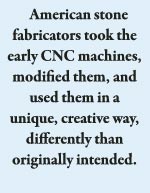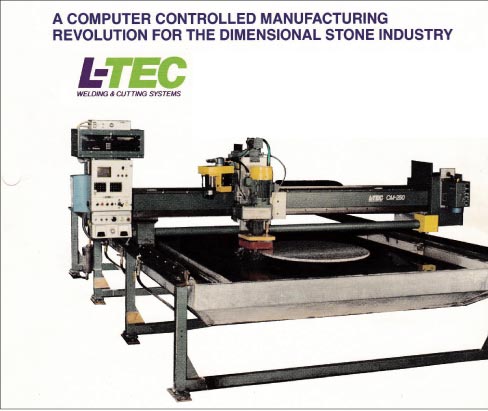Will the Stone Industry Play a Part in the Coming Manufacturing Revolution?
Mark McMunn
The stone industry has always attracted a type of hardcore, self-reliant person that seeks not just to make a living and profit, but craves the satisfaction of taking something very hard to do and through will and effort create things to be used and enjoyed by other people.
 The only other profession that even comes close to the stone industry in this regard is the foundry profession and specifically the foundries that produce bronze statues of human likenesses that impart the spirit of man’s greater good. No matter how far humankind goes in adapting robots to do the work that was once done by humans, the people spoken of above will always be the master of the machines, because no matter how many axes a machine may have that can mimic the “how” of making things, there will never be enough lines of code written that will ever be able to mimic the “why” of why we make things. It is important before we continue that homage is paid to our artisans whose work throughout history has been the genesis of many an industry.
The only other profession that even comes close to the stone industry in this regard is the foundry profession and specifically the foundries that produce bronze statues of human likenesses that impart the spirit of man’s greater good. No matter how far humankind goes in adapting robots to do the work that was once done by humans, the people spoken of above will always be the master of the machines, because no matter how many axes a machine may have that can mimic the “how” of making things, there will never be enough lines of code written that will ever be able to mimic the “why” of why we make things. It is important before we continue that homage is paid to our artisans whose work throughout history has been the genesis of many an industry.
Now we are at the beginning of a new administration that, whether you care for it or not, has pledged to make a priority of returning the United States to its old place of preeminence among the manufacturers of the world. Generous post WW2 policies of the United States that were successful in the restoration of the economies of our defeated enemies had already worked by the mid 1960s. Perhaps they should have stopped those policies decades years ago, when those economies had been restored to above prewar capacity. Continuing those policies beyond that point started to backfire as we found ourselves subsidizing foreign companies to compete against our own companies here at home. Those very policies are the reason that today there are only about a half dozen fully vertically integrated granite and marble producers in the United States, versus scores of them prewar. Do we finally have a chief executive that clearly understands that our nation is now at risk of having to go hat in hand, for products we no longer produce, to nations that at best have a smug attitude towards America? Okay, enough complaining because that is all water under the bridge. What about the future of manufacturing in America and the stone industry’s impact upon it?
 |
|
The Linde Marble Cutter was essentially a torch cutter for metal adapted with a spindle to cut marble. Cutting granite was out of the question because the diamond tools available at the time could not cut granite very well, and the spindle just did not have the power to overcome the low-grade diamond tooling. |
The stone industry has undergone a truly revolutionary change in just the past 16 years beginning with the “Odyssey” CNC machine by Park Tool. Park’s first-generation CNC was not the first attempt to bring automation to the stone industry. Old timers will recall the Linde “Marble Cutter” introduced in the mid 1980s that was a true CNC machine, but it failed because the cost of the diamond tooling was prohibitive – and it could not work granite, much less polish it. Yes, yes, there were already Italian CNC machines out there at the time, but we are talking about American manufacturing here. What was unique to Park’s machine was that it had integrated sawing, routing and coring into one machine, and it was available here in the USA and not from across the ocean. Today, the “Odyssey” seems crude compared to Park’s latest iteration the “Titan,” which has incredible production capability.
However, it’s not really the machines themselves that are the focus of this discussion, but rather how our American fabricators took these CNC machines, modified them, and used them in a unique way, not the original intended use of CNC machines.
It is this American spirit of despising mediocrity and not settling for what others tell them are their “only” choices that has put American countertop fabricators WAY ahead of our foreign counterparts in custom countertop fabrication techniques used for homes and commercial finish-outs. (There needs to be a frank discussion about the Chinese lock on mass-produced countertops, but because that discussion is rife with political posturing, it is perhaps not appropriate for this newspaper). However, a “New Order” in international trade is long overdue.
So how is the stone industry changing the overall manufacturing sector here in the USA? Lets begin by understanding that CNC machines were originally built to mass-produce millions of the same part, and many CNC machines still do this today, but mainly in the metalworking and woodwork industries. In the stone industry we saw for the first time in any industry CNC being used to run singularly unique parts in quick succession. This is more commonly referred to as “one-off” production, which was not practical in the past because the set up time was too long to be profitable. Admittedly, the new CNC machines can still be set up to make mass production “cookie cutter” projects with ease, but that is not where the business is right now.
What did the American fabricator change? For one thing, the CNC machines available from Europe back in the 1980s and 1990s were difficult to load because the work bed was often high off the floor, which also made it difficult to unload, and the work footprint did not allow the fabricator to place a full slab onto the work surface. The problem with the European machines was that they were not geared to countertop production in a practical way. It was the American machine manufacturers that first listened to and heeded the complaints of the fabricators and made the machines much more user friendly, to the point where making one-off projects have become the norm instead of the exception. In turn, this has made mass production of custom kitchen countertop projects possible. Were the terms “mass production” and “custom” just used in the same sentence? The same forces are responsible for the laser measuring devices that are now used to digitally measure jobs rather than use of a measuring tape – and let’s not forget the innovative suction pods – American made – that also have played their part in the business.
To many of you reading these words, nothing written here is new, but what may be unrealized right now is that other industries have seen what the stone industry has accomplished with the CNC machine and it will change the thinking of other manufacturing industries as well. Historically we are due for another manufacturing revolution, and hopefully it has been shown here that the stone industry has in no small way contributed to that oncoming revolution.